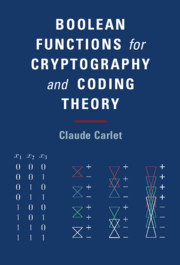Refine search
Actions for selected content:
48532 results in Computer Science
Disjointness graphs of segments in the space
- Part of
-
- Journal:
- Combinatorics, Probability and Computing / Volume 30 / Issue 4 / July 2021
- Published online by Cambridge University Press:
- 04 November 2020, pp. 498-512
-
- Article
- Export citation
Evidence-driven policy-making using heterogeneous data sources—The case of a controlled parking system in Thessaloniki
-
- Journal:
- Data & Policy / Volume 2 / 2020
- Published online by Cambridge University Press:
- 03 November 2020, e15
-
- Article
-
- You have access
- Open access
- HTML
- Export citation

Boolean Functions for Cryptography and Coding Theory
-
- Published online:
- 31 October 2020
- Print publication:
- 07 January 2021
7 - Avoiding the Hype Cycle
-
- Book:
- The Chief Data Officer's Playbook
- Published by:
- Facet
- Published online:
- 18 February 2021
- Print publication:
- 30 October 2020, pp 69-78
-
- Chapter
- Export citation
Preface
-
- Book:
- The Chief Data Officer's Playbook
- Published by:
- Facet
- Published online:
- 18 February 2021
- Print publication:
- 30 October 2020, pp xiii-xviii
-
- Chapter
- Export citation
Frontmatter
-
- Book:
- The Chief Data Officer's Playbook
- Published by:
- Facet
- Published online:
- 18 February 2021
- Print publication:
- 30 October 2020, pp i-vi
-
- Chapter
- Export citation
13 - What type of Chief Data Officer are you?
-
- Book:
- The Chief Data Officer's Playbook
- Published by:
- Facet
- Published online:
- 18 February 2021
- Print publication:
- 30 October 2020, pp 123-130
-
- Chapter
- Export citation
8 - Relating to the rest of the Business, Especially the C-Suite
-
- Book:
- The Chief Data Officer's Playbook
- Published by:
- Facet
- Published online:
- 18 February 2021
- Print publication:
- 30 October 2020, pp 79-84
-
- Chapter
- Export citation
Contents
-
- Book:
- The Chief Data Officer's Playbook
- Published by:
- Facet
- Published online:
- 18 February 2021
- Print publication:
- 30 October 2020, pp vii-x
-
- Chapter
- Export citation
16 - The Hoarding Mentality and how to Break it
-
- Book:
- The Chief Data Officer's Playbook
- Published by:
- Facet
- Published online:
- 18 February 2021
- Print publication:
- 30 October 2020, pp 147-160
-
- Chapter
- Export citation
Glossary of Technical Terms
-
- Book:
- The Chief Data Officer's Playbook
- Published by:
- Facet
- Published online:
- 18 February 2021
- Print publication:
- 30 October 2020, pp xxv-xxviii
-
- Chapter
- Export citation
18 - The Chief Data Officer and Data Governance
-
- Book:
- The Chief Data Officer's Playbook
- Published by:
- Facet
- Published online:
- 18 February 2021
- Print publication:
- 30 October 2020, pp 169-178
-
- Chapter
- Export citation
Index
-
- Book:
- The Chief Data Officer's Playbook
- Published by:
- Facet
- Published online:
- 18 February 2021
- Print publication:
- 30 October 2020, pp 207-213
-
- Chapter
- Export citation
21 - Conclusion
-
- Book:
- The Chief Data Officer's Playbook
- Published by:
- Facet
- Published online:
- 18 February 2021
- Print publication:
- 30 October 2020, pp 203-206
-
- Chapter
- Export citation
Acknowledgements
-
- Book:
- The Chief Data Officer's Playbook
- Published by:
- Facet
- Published online:
- 18 February 2021
- Print publication:
- 30 October 2020, pp xix-xxii
-
- Chapter
- Export citation
4 - The Secret Ingredients of a Chief Data Officer
-
- Book:
- The Chief Data Officer's Playbook
- Published by:
- Facet
- Published online:
- 18 February 2021
- Print publication:
- 30 October 2020, pp 31-42
-
- Chapter
- Export citation
12 - The Different Generations of Chief Data Officers
-
- Book:
- The Chief Data Officer's Playbook
- Published by:
- Facet
- Published online:
- 18 February 2021
- Print publication:
- 30 October 2020, pp 111-122
-
- Chapter
- Export citation
About the authors
-
- Book:
- The Chief Data Officer's Playbook
- Published by:
- Facet
- Published online:
- 18 February 2021
- Print publication:
- 30 October 2020, pp xxiii-xxiv
-
- Chapter
- Export citation
1 - The Accidental Entrepreneur
-
- Book:
- The Chief Data Officer's Playbook
- Published by:
- Facet
- Published online:
- 18 February 2021
- Print publication:
- 30 October 2020, pp 1-8
-
- Chapter
- Export citation



